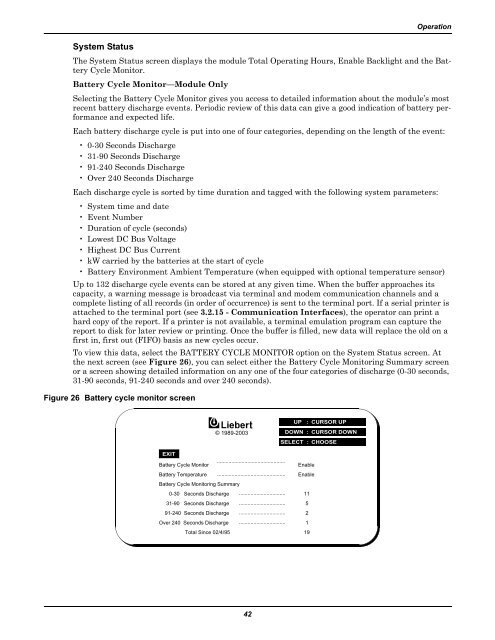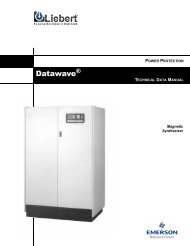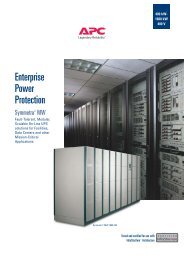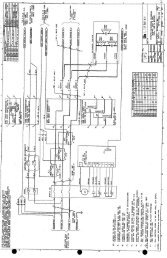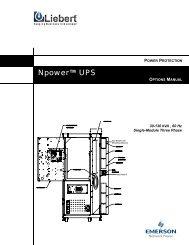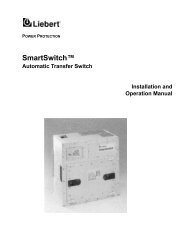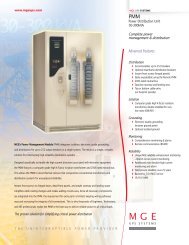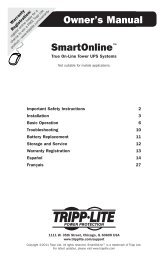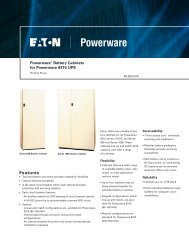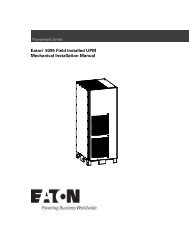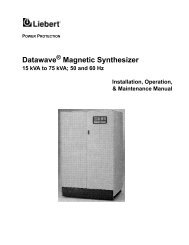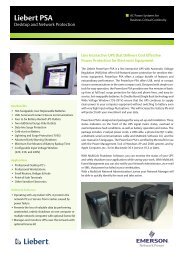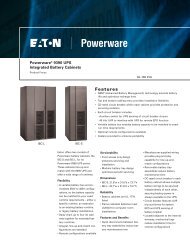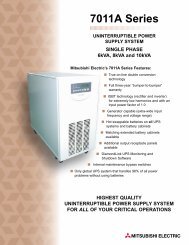Liebert® Series 610™ UPS - Jonweb.net
Liebert® Series 610™ UPS - Jonweb.net
Liebert® Series 610™ UPS - Jonweb.net
You also want an ePaper? Increase the reach of your titles
YUMPU automatically turns print PDFs into web optimized ePapers that Google loves.
System Status<br />
Operation<br />
The System Status screen displays the module Total Operating Hours, Enable Backlight and the Battery<br />
Cycle Monitor.<br />
Battery Cycle Monitor—Module Only<br />
Selecting the Battery Cycle Monitor gives you access to detailed information about the module’s most<br />
recent battery discharge events. Periodic review of this data can give a good indication of battery performance<br />
and expected life.<br />
Each battery discharge cycle is put into one of four categories, depending on the length of the event:<br />
• 0-30 Seconds Discharge<br />
• 31-90 Seconds Discharge<br />
• 91-240 Seconds Discharge<br />
• Over 240 Seconds Discharge<br />
Each discharge cycle is sorted by time duration and tagged with the following system parameters:<br />
• System time and date<br />
•Event Number<br />
• Duration of cycle (seconds)<br />
• Lowest DC Bus Voltage<br />
• Highest DC Bus Current<br />
• kW carried by the batteries at the start of cycle<br />
• Battery Environment Ambient Temperature (when equipped with optional temperature sensor)<br />
Up to 132 discharge cycle events can be stored at any given time. When the buffer approaches its<br />
capacity, a warning message is broadcast via terminal and modem communication channels and a<br />
complete listing of all records (in order of occurrence) is sent to the terminal port. If a serial printer is<br />
attached to the terminal port (see 3.2.15 - Communication Interfaces), the operator can print a<br />
hard copy of the report. If a printer is not available, a terminal emulation program can capture the<br />
report to disk for later review or printing. Once the buffer is filled, new data will replace the old on a<br />
first in, first out (FIFO) basis as new cycles occur.<br />
To view this data, select the BATTERY CYCLE MONITOR option on the System Status screen. At<br />
the next screen (see Figure 26), you can select either the Battery Cycle Monitoring Summary screen<br />
or a screen showing detailed information on any one of the four categories of discharge (0-30 seconds,<br />
31-90 seconds, 91-240 seconds and over 240 seconds).<br />
Figure 26 Battery cycle monitor screen<br />
UP : CURSOR UP<br />
© 1989-2003<br />
DOWN : CURSOR DOWN<br />
SELECT : CHOOSE<br />
EXIT<br />
EXIT<br />
Battery Cycle Monitor<br />
Battery Temperature<br />
...............................................<br />
...............................................<br />
Enable<br />
Enable<br />
Battery Cycle Monitoring Summary<br />
0-30 Seconds Discharge<br />
31-90 Seconds Discharge<br />
91-240 Seconds Discharge<br />
Over 240 Seconds Discharge<br />
Total Since 02/4/95<br />
................................<br />
................................<br />
................................<br />
................................<br />
11<br />
5<br />
2<br />
1<br />
19<br />
42


